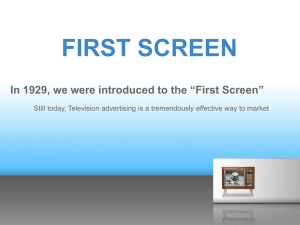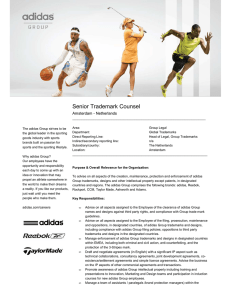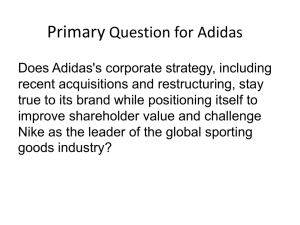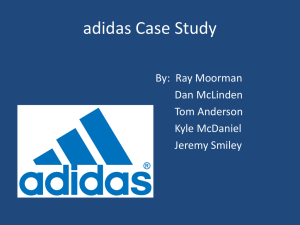What enabled Adidas to be the Market Leader in
advertisement
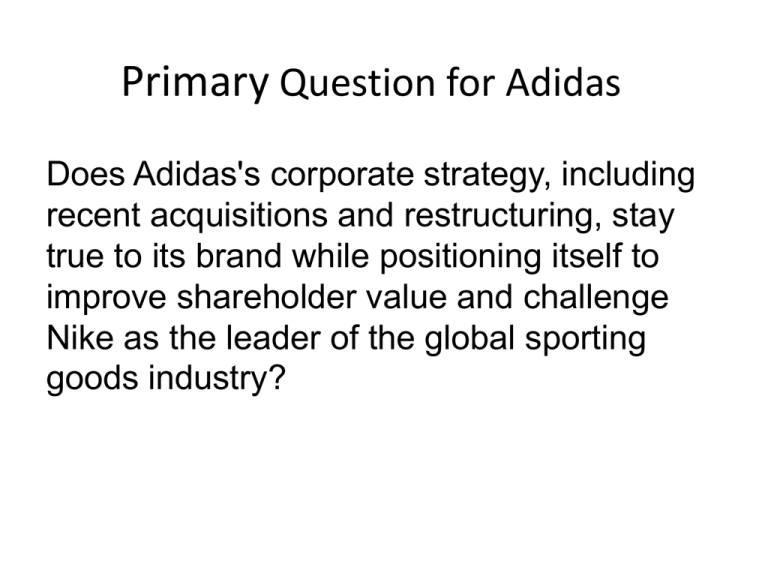
Primary Question for Adidas Does Adidas's corporate strategy, including recent acquisitions and restructuring, stay true to its brand while positioning itself to improve shareholder value and challenge Nike as the leader of the global sporting goods industry? • • • • • • • • Secondary Questions What enabled Adidas to be the market leader in the past? How did Adidas lose the lead to Nike? What has the Adidas brand represented in the past and what does it represent today? How has Adidas' corporate strategy changed over time, specifically before and after the 2005-2006 restructuring? Have Adidas' acquisitions helped improve their position against the competition? What role do developing countries have in Adidas's future success and how is Adidas positioned in those countries? Should Adidas be concerned about losing North American market share to Nike? Is there another corporate strategy Adidas should be pursuing? What enabled Adidas to be the Market Leader in the past? Product Innovation Analysis – Adidas was an early entrant into athletic shoe industry. They developed many of the features still present in shoes today. Strong presence in Olympics and soccer. Created a strong brand based on high quality, innovative products that top athletes choose to use in training and competition. Track and Field • 1925:studs and spikes • Arch support • 1949 – molded rubber cleats • 1952 screw in spikes Soccer • 1954 – screw in spikes • 1963- Began producing soccer balls • 1967 – athletic apparel Results • Over 700 patents • Strong reputation among top athletes • 1970 – leading brand in consumer jogging shoes Marketing Innovation •Developed strong following with top track and field athletes. Gave shoes to German athletes in 1928 Olympics •Applied this same model years later with soccer shoes and apparel. 75% of track and field athletes wearing adidas in 1960 Olympics •Successful because adidas was creating innovative, high quality products. •Product innovation enabled marketing innovation. •Different than Nike – marketing is what set them apart from the start. 2 stripe (and later 3 stripe) brand 78% of athletes wearing adidas at 1972 Olympics How did Adidas lose the lead to Nike? How Did adidas Lose US Market Share to Nike? Nike adidas Nike emerging in the 70’s Innovative leader dies in1978 – quality declines, innovation drags Aggressive launch new styles – going after youth and fitness craze Dedicated to competitive athletes Large endorsement contracts – sign Michael Jordan Passed on Michael Jordan Focused, aggressive, dedicated leadership 8 years of management and ownership changes Outsourcing of manufacturing to Asia Costly German manufacturing facilities What has the Adidas brand represented in the past and what does it represent today? How has Adidas's corporate strategy changed over time, specifically before and after the 2005-2006 restructuring? Adidas Evolving Strategy Return to form via restructuring… Loss of focus… Adi’s leadership… Focused on athletic footwear/apparel. Success factors are marketing and product innovation. Focused on Puma, while Nike underestimated. Tries to catch up via acquisitions which yields product breadth instead of specialization. Design and Innovation, differentiated image for brands, improved retail and supply chain Adidas’ Current Strategy Have Adidas’s acquisitions helped improve their position against the competition? Salomon Acquisition: Was it Successful? Product Line Before Product Line After Athletic Shoes Athletic Shoes Athletic Apparel Athletic Apparel Ski Equipment Golf Clubs Bicycle equipment Winter Sports Apparel •Analysis:Paid 1.5bn to diversify product line. Surpassed Reebok world’s 2nd largest sporting goods company, however… Adidas’s Stock Price 60 Stock Price (in euros) 50 40 30 Adidas Stock Price 20 10 0 1999 2000 2001 2002 2003 2004 2005 2006 2007 2008 Year •Stock price fell soon after acquisition in 1998, Salomon divested except for Taylor-Made Golf line. Adidas overpaid for acquisition. Adidas after Salomon was divested Product Line Before Athletic Shoes Product Line After Athletic Shoes Product Line After Divestiture Athletic Shoes Athletic Apparel Athletic Apparel Athletic Apparel Ski Equipment Golf Clubs* Golf Clubs Bicycle equipment Winter Sports Apparel •Net addition was TaylorMade golf TaylorMade-Adidas Golf Sales by Product Line 350 300 250 200 Sales (in millions) 150 Metalwoods Apperal Footware Other Hardware 100 50 0 2004 2005 2005 2007 Year Conclusion: TaylorMade/Adidas has been able to keep sales up through athlete endorsements even though USGA rules have limited tech advances & an industry decline in the number of golfers. 2007 TaylorMade/Adidas Golf Sales Breakdown Other Hardware 31% Footwear 9% MetalWoods 42% Apperal 18% MetalWoods Apperal Footwear Other Hardware Conclusion: Use Adidas’s marketing model of track & field/soccer shoes to gain more sales in footwear & apparel. SWOT Analysis for Reebok Weaknesses Strengths •Strong in hockey, football and baseball •Loyal female customer base •Past success in marketing •Strong stable of professional athlete endorsements •Poor reputation for quality and innovation •Greg Norman golf apparel brand •Limited distribution channels Opportunities • Encouraging sales growth in Latin America and Asia •Economies of scale with Adidas supply chain and distribution Threats • Possibility of cannibalization if sold in same place as Adidas products • Still third in market share in its strongest market, North America Reebok Acquisition •On paper it looks like Reebok’s product portfolio, endorsements and relationships round out Adidas and together they can join forces to overtake Nike. •Issue is can management overcome Reebok’s reputation for poor quality and lack of innovation? •Can two companies come together with such different cultures and focus? •Adidas – product innovation and commitment to quality •Reebok – marketing focus Adidas Reebok Basketball Hockey Running Baseball Soccer Football What role do developing countries have in Adidas's future success and how is Adidas positioned in those countries? Adidas is a global player •43% of sales from Europe, which is slowest growth market •Encouraging that #1 in developing eastern European market, Russia expected to be most profitable market in Europe by 2010 •2006 acquisition of Reebok not enough to overcome Nike in North America •Growing number of sales in Asia market, fueled by adidas success in China. •Strong demand and large population Net Sales in Emerging Markets Analysis – strong growth trend in sales in two very attractive emerging markets. Growth may be result of Adidas brand strength in soccer, world’s most popular sport. Regional Footwear/Apparel Markets Region Size Market Growth Rate Adidas Sales Adidas Sales Growth Adidas Position North America $42.5 billion 3% $2.9 billion 5% #2 behind Nike Europe N/A 2% (20% Eastern Europe) $4.3 billion 8%, mainly in Russia #1 Asia 3.2 billion people 13% (South and Central) 15% (China) $2.2 billion 17% #1 Latin America N/A N/A $657 million 39% #2 behind Nike Analysis – Adidas is strong in several developing markets (Eastern Europe, China) but its focus and acquisitions have been geared towards overtaking Nike in the large, but slow growth North America market. Should Adidas be concerned about losing North American market share to Nike? Retail Store Strategy 2006 2007 Adidas Retail Locations 875 1003 Reebok Retail Locations 283 430 Adidas AG Geographic Revenue Performance € 5,000 € 4,500 5.0% 31.5% € 4,000 € 3,500 106.4% 3.2% € 3,000 -9.4% Europe North America € 2,500 11.6% € 2,000 32.6% 17.6% € 1,500 Asia Latin America 27.8% € 1,000 1229.2% € 500 56.4% 31.7% €0 2004 2005 2006 2007 Key Growth Potential: Europe – continue focus on soccer (including endorsements) and build brand loyalty Asia/Latin America – increase distribution network and brand awareness - All three regions averaging double-digit growth rates TaylorMade Advantages Shift to International Markets Strength in Metalwoods Revenues from Asia: 1999 – 13% of total 2007 – 35% of total Metalwoods currently hold number one ranking. Decreasing reliance on U.S. Market: 1999 – 69% of total 2007 – 52% of total Irons hold less than half market share of industry leader Strong Apparel Presence Over 70 touring pros lift apparel presence. Golf balls have seen limited success Conclusion – TaylorMade should hold U.S. market share in U.S. given the brand’s strengths, however, TM is only 8% of Adidas AG global revenues. TM cannot help Adidas overtake Nike in U.S. market TM 8% Reebok 23% Adidas 69% Adidas Global Revenue Sources (2007) 6.4% Remaining regions = 71.3% of revenues 22.1% 42.8% Europe North America Asia Latin America Conclusion – The majority of Adidas’s revenue streams are outside U.S. market and are growing significantly – let Nike lead U.S. market but dominate Europe and emerging markets. N.A. market 28.7% of revenues Reebok Global Revenue Sources (2004) 11.4% 21.4% 12.5% Europe United Kingdom United States Other Countries 54.7% Conclusion – Use Adidas’s control and production efficiencies to enhance Reebok’s distribution network in U.S. to increase U.S. revenues. U.S. market 54.7% of 2004 revenues Is there another corporate strategy Adidas should be pursuing? Alt Strategy Options • Use Adidas as revenue driver outside of U.S. market – restructure Reebok strategy to capitalize on historic revenue performance in U.S. – Decrease number of Adidas retail outlets in U.S. convert to Reebok retail – Increase Reebok U.S. endorsements • Use Adidas global distribution to further increase TaylorMade international revenues Slides that follow still need to be placed or cut. External Environment: PEST Issue Threats/Opportunities Ranking (1-5) Political Operating multi-nationally – awareness of cultures, laws, image, environment, regulations Threat- mistakes can be costly 2 Economic Current state of economy – customers may be less willing to pay for higher priced items Threat – high quality means higher prices 2 Extreme forces in competitor pricing. Opportunity – supply chain efficiencies and multiple distribution channels 4 Category Social Keeping up with the wants of the younger generation Opportunity – Reebok’s strength in this area 4 Technological Product innovation is a key driver in the industry Opportunity – core competency for adidas 4 Porter’s 5 Forces Threat of Substitutes Low Bargaining Power of Suppliers Low Intensity of Competition High Bargaining Power of Buyers High Threat of New Entrants Low Porter’s Five Forces Factor Description Impact •adidas’s strength is product innovation and meeting customer expectations Low •Strong presence of established brands and distribution channels •Customers already loyal to their brand •Huge resources required of new entrants Low Bargaining Power of Buyers •Huge number of buyers means adidas must market products effectively •Must be able to differentiate from the competition •Buyers more conscious of their spending •Buyers have access to more information High Bargaining Power of Suppliers •Multiple sources of materials for shoes and apparel – commodity status •Suppliers are very dependent on adidas and others •Ease in switching suppliers if necessary and can do so globally Low •Recent acquisitions in industry •All competition has global reach – internet and e-commerce •Remaining a leader is expensive – aggressive sales and marketing •Always struggling to get a competitive edge High Threat of Substitute Products Threat of New Entrants Competitive Rivalry

